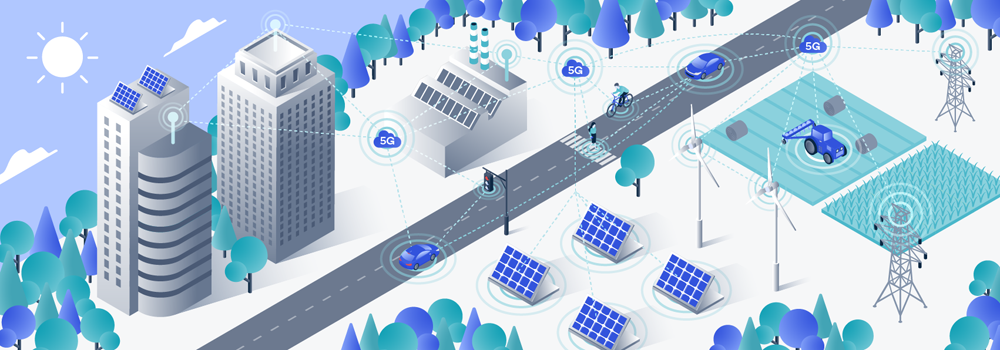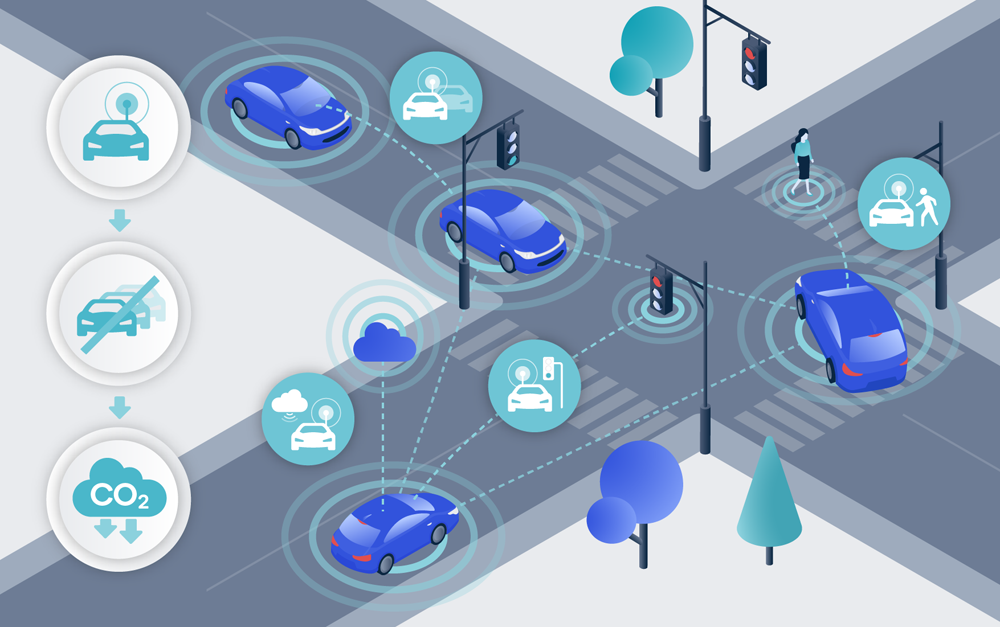
By 2050, the Earth’s population is expected to increase from seven to 10 billion people, quadrupling economic activity and creating increased demand for energy and natural resources. This new economy is projected to use 80% more energy than today. Reducing energy waste and pollution will be essential for combatting the social, economic, and environmental impacts of climate change. Qualcomm Technologies believes digital technology is a critical lever for helping to address this global energy challenge. With ultra-high-speed connectivity, greater reliability, and lower latency, 5G provides a platform for innovation that brings tremendous opportunities to improve efficiencies and achieve tangible sustainability benefits.
When compared to current 2G-4G networks, 5G is expected to decrease greenhouse gas emissions (CO2 and equivalents) by 85% per unit of data transmitted. 5G can also support new services and applications that can help improve energy efficiencies across many industrial sectors such as transportation, energy, agriculture, and manufacturing. Additionally, designed specifically for transportation, cellular-to-everything (C-V2X) can complement use of 5G networks and provide short-range connectivity for low-latency, safety-critical and mobility-benefiting applications. Together, these communications technologies can reshape the transport sector by decreasing road incidents for safer travels and improving traffic efficiency for lower greenhouse gas emissions such as CO2 and NOx.
Connected transportation
The digitalisation of transportation and resulting cleaner mobility is likely going to play a key role in reducing emissions. Once vehicles are connected to everything around them, transportation systems may be able to support new services that could help improve road incidents, trip planning, mode choices and traffic efficiency – enhancements that can lower emissions and reduce fuel consumption, making roads safer, and travel more comfortable and faster for everyone.
 Wireless technologies can serve as the backbone for this digital transformation. And for the transportation industry, the journey to ubiquitous connectivity starts with deploying C-V2X technology in vehicles and roadside infrastructure today. C-V2X allows vehicles to communicate directly with other vehicles, roadside infrastructure, and pedestrians. Having this ability to share information in real-time allows road users and infrastructure to operate in cooperation and coordination, which can make travel safer and more sustainable. For example, a possible result of safer travel is the reduction of crashes and road deaths. Crashes and other non-recurring incidents account for about half the congestion problem in some parts of the world. Hence, there is a direct line between safety and sustainability. C-V2X can also encourage new use cases such as manoeuvre coordination, which can contribute to the reduction of emissions when deployed at scale.
Wireless technologies can serve as the backbone for this digital transformation. And for the transportation industry, the journey to ubiquitous connectivity starts with deploying C-V2X technology in vehicles and roadside infrastructure today. C-V2X allows vehicles to communicate directly with other vehicles, roadside infrastructure, and pedestrians. Having this ability to share information in real-time allows road users and infrastructure to operate in cooperation and coordination, which can make travel safer and more sustainable. For example, a possible result of safer travel is the reduction of crashes and road deaths. Crashes and other non-recurring incidents account for about half the congestion problem in some parts of the world. Hence, there is a direct line between safety and sustainability. C-V2X can also encourage new use cases such as manoeuvre coordination, which can contribute to the reduction of emissions when deployed at scale.
When complemented by 5G networks, C-V2X can support exceptionally reliable, low latency local group broadcast to truly enhance vehicle automation. 5G can support entire transportation systems to become even smarter and more efficient – improving traffic flow and supporting real-time route guidance to reduce congestion, adjusting vehicle dynamics for optimal speed with fewer stops and less idling, and informing new mobility services for additional travel options.
More sustainable transportation
Deploying C-V2X allows vehicles, infrastructure and vulnerable road users to exchange actionable information in real-time today, and 5G network deployments can support broader information sharing and more advanced use cases for even safer, greener cities in the future. Some use cases that could have the biggest impact on the environment include:
- Dynamic path planning for better decision making in situations where stop and go traffic can be avoided
- Real-time sharing of local data between infrastructure and vehicles (for instance, HD maps) to improve traffic flow and parking for a more efficient journey
- Smart traffic management systems that use sensor data and modelling to manage real-world traffic flows and avoid congestion
- Sensor data sharing between vehicles for more predictable and coordinated driving to reduce braking and stopping while enhancing road safety
Making cities more sustainable will take more than just smarter, more efficient transportation systems, it will also require connected mobility solutions that support more informed, personalised travel options. Whether it’s a business operating freight trucks during off-peak hours or an individual choosing an alternate toll route to shorten travel times, services that come from connected, digitised transportation systems can inform better choices that can lead to even greater reductions in emissions and energy usage. In an environment where all road users and traffic management systems are connected, every use case that helps to improve efficiency is an incremental step toward a more sustainable future.
Potential impact of C-V2X
A recent study titled Environmental Benefits of C-V2X from the 5G Automotive Association (5GAA) shows the impact a large-scale C-V2X deployment could have on the environment and identifies several promising use cases for reducing emissions and fuel usage, including targeting individual vehicle driving dynamics, managing traffic flow and influencing traveller behaviour.

Results from the study indicate that use cases helping vehicles to avoid unnecessary braking and stopping have the most potential for impact. For example, predictive cruise control was shown to reduce carbon emissions by up to 36% and fuel usage up to 47% – while a use case focused on cooperative adaptive cruise control for a lane closer led to a fuel reduction of up to 33%.
With their ability to impact traffic flow, eco-signals and eco-lanes also show significant promise for improving inefficiencies and creating more sustainable roadways. Simulations predict that eco-signalling can reduce fuel usage by up to 13% and NOx emissions by up to 20%.
Systems that let drivers know the optimal speed to approach traffic signals, so they arrive when lights are green, have also been shown to significantly reduce vehicle emissions. The Transport Technology Forum recently conducted a trial demonstrating that Green Light Optimised Speed Advisory (GLOSA), a connected vehicle technology which collects traffic signals timings, can cut more than a quarter of CO2 emissions and nearly a fifth of NOx from heavy goods as vehicles leave the motorway.
In addition to its environmental benefits, reliable, real-time communication with C-V2X also supports safety applications for drivers, pedestrians, cyclists, and roadway workers. For example, Red Light Violation Warnings (RLWV) that notify drivers when their vehicle is likely to run a red light have been shown to reduce fatalities and injuries on urban roads by 3.8% and 7.0%, respectively.
Connected driving and increasing levels of automation have the potential to make vehicles and roadways safer and more efficient, improving traffic congestion to reduce emissions and help save the planet from climate change. Deploying C-V2X to support Day One services today is the first step, and the environmental benefits can only get better as 5G networks continue to bring high-speed, ultra-reliable connectivity to more regions around the world.
Learn more about C-V2X and 5G at qualcomm.com
Download the 5GAA study: Environmental Benefits of C-V2X
Sponsored content produced in association with Qualcomm
References
- https://www.un.org/development/desa/en/news/population/world-population-prospects-2019.html
- Next generation mobile networks: Problem or opportunity for climate protection?
- U.S. Department of Transportation Federal Highway Administration
- https://highways-news.com/glosa-trial-shows-dramatic-environmental-benefits/
- Kareen El Beyrouty et al., Support Study for Impact Assessment of Cooperative Intelligent Tansport Systems





